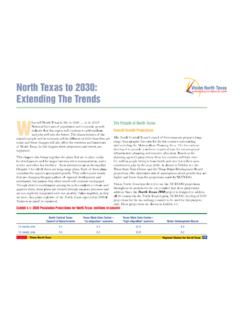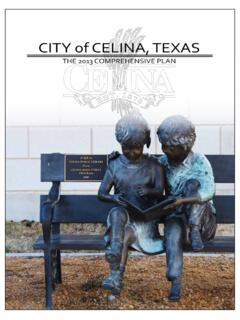Transcription of Club Industry Trends and Economic Outlook
1 Copyright 2009, National Club Association. All Rights ReservedClub Industry Trends and Economic Outlook Douglas Howe, DirectorNational Club Association1201 15th St., NW, Suite 450 Washington, DC 200051 (800) 625 11, 2010 Copyright 2009, National Club Association. All Rights ReservedPrivate Club & Consumer TrendsDemographic Influences on Private ClubsEconomic Influences on Private ClubsCopyright 2009, National Club Association. All Rights ReservedDemographic Influences on Private ClubsCopyright 2009, National Club Association. All Rights ReservedDemographic OverviewThe American population is changing at a rapid paceA record number of babies 4,315,000 were born in the in 2007. The last time the number was that high was in 1957 in the middle of the baby boomThe population is expected to reach 439 million by 2050, from 296 million in 2005, according to the Pew Research Center 82% of that increase will be due to immigrants arriving between 2005 and 2050 Source: NCA Planning Survey, 2009 Copyright 2009, National Club Association.
2 All Rights Historical & Projected PopulationCurrent population 308 MillionSource: U. S. Census BureauProjected population 439 MillionCopyright 2009, National Club Association. All Rights Reserved2010 308,936,000 10%2020 335,805,000 19%2030 363,584,000 29%2040 391,946,000 39%2050 419,854,000 49%YearProjected populationPercent change from population in population Growth ProjectionsSource: Census BureauCopyright 2009, National Club Association. All Rights Reserved The population increased not because people started breeding like rabbits, but because they stopped dying like flies. ~ Nicholas EberstadtHarvard University Demographer Copyright 2009, National Club Association. All Rights ReservedSource: U. S. Census BureauProjected population Growth(Top 20 States)Copyright 2009, National Club Association. All Rights ReservedAmerica s 10 Fastest Growing States1. Utah2. Arizona3. Texas4. North Carolina5. Colorado6.
3 Idaho7. Wyoming8. Nevada9. Georgia10. South CarolinaSource: ForbesCopyright 2009, National Club Association. All Rights ReservedHighest Percent Of MinoritiesHispanic or Latino Black or African American American Indian and Alaskan nativeAsian Native Hawaiian and other Pacific IslanderTwo or more races, not Hispanic or LatinoSource: (by County population ) Approximately 1/3 (100MM) of Residents are a minority The minority population of the is larger than all but 11 countries. Copyright 2009, National Club Association. All Rights ReservedChange in PopulationProjected Racial Changes Based on Current Rate of ImmigrationSource: National Research Council StudyThe minority population is approximately 12% of the population today by 2050 it is projected to be 19%. 19952050 Copyright 2009, National Club Association. All Rights ReservedWorking GenerationsMillions01020304050607080 MillenialsGen XersBabyBoomersMatures(1980-1995)(1965-1 979)(1946-1964)(<1945)76MM74MM45MM(Aka:G en Y,Echo Boomers)32 MMMulti-Generational WorkforceMaturesBoomersGen XersMillenialsEntry Into WorkforceRetirementTenureCopyright 2009, National Club Association.
4 All Rights ReservedPopulation Age SegmentationCopyright 2009, National Club Association. All Rights ReservedMass Affluent Top 5% households with earnings greater than $150K annually There are roughly 33 million mass affluent households in US They own roughly 37% of America's liquid financial assets 93% own their own home, half of those mortgage free The Mass Affluent represents over 5 million millionaires in the Well educated, well traveled and well connected Most are time starved and covet their leisure and recreational time with friends and family Source: Various Federal Reserve, Spectrum Group, Copyright 2009, National Club Association. All Rights ReservedGolf Clubs & Members The number of private golf clubs throughout the is approximately 4,400, or about 30% of all golf facilities Currently, there are million private club adult golfers inthe , which represent about 9% of all adult golfers and6% of the Mass Affluent Private golfers are important to the golf Industry becausethey are disproportionately avid players and spenders versuspublic golfers Private club golfers play 3x as much as public golfers andspend 3x as much The majority joined their clubs before they turned 50 years oldSource: National Golf FoundationCopyright 2009, National Club Association.
5 All Rights Reserved15%31%30%16%9%18-2930-3940-4950- 5960+Source: National Golf FoundationAge First Joined Club(Current Country Club Members)The Millennials are reaching the age when, historically, the majority of current members joined a country club (30 39 years old)Copyright 2009, National Club Association. All Rights ReservedGeneration X: Nearly 70% shop and bank online 21% read a blog once per month 61% send text messagesGeneration Y: 90% own a computer 82% own a mobile phone 72% send or receive SMS messages They spend more time online than watching television 42% watch online videos at least once per monthGenerations X & Y ProfileSource: NCA Planning Survey, 2009 Social Networking and Technology are the Primary Lifestyle InterestsCopyright 2009, National Club Association. All Rights ReservedReaching the Next Generation Online Networking is Required The One Way Website is Dead Tweet to Greet, Meet, & Eat Mass Mingling Profile Myning Life On DemandSocial NetworkingSource: Equation Research 2009 Social Networkers by Age75% of 18 2457% of 25 3430% of 35 4419% of 45 5410% of 55 647% of 65 and olderCopyright 2009, National Club Association.
6 All Rights ReservedClubs must be prepared to deliver MULTI CULTURAL&MULTI GENERATIONAL programming, events, menu offerings, and experiences to attract and retain future this 2009, National Club Association. All Rights ReservedEconomic Influences on Private ClubsCopyright 2009, National Club Association. All Rights ReservedConsumer Confidence TrendSource: The Conference BoardCopyright 2009, National Club Association. All Rights ReservedHousing Sales Price TrendIn September 2009, of all mortgages outstanding were either delinquent or in foreclosure significantly affecting home sale pricesSource: Mortgage Bankers Association Survey 3rd Qtr 2009 Copyright 2009, National Club Association. All Rights ReservedGovernment SpendingSource: US Government $6, 582B = 2009 SpendingCopyright 2009, National Club Association. All Rights ReservedBehavioral InfluencesSource: Dr. Scott Smith, Institute of Marketing, Brigham Young University, December 2008 Copyright 2009, National Club Association.
7 All Rights Reserved* = one person trip of 50 miles or more, one way, away from home or including one or more nights away from homeTravel TrendsCopyright 2009, National Club Association. All Rights ReservedAffect of Economy on ClubsThe NCA Planning Survey, from January 2009, focused on the impact the economy has had on private clubs throughout the countryRespondents were asked to indicate the degree to which factors related to the financial health of their club were healthy or a challenge for 84% reported that the quality of their membership services continues to be very healthy Nearly 75% rated their ability to cover debt service as very strong Just over 50% rated their club s cash flowand capital reserves as healthySource: NCA Planning Survey, 2009 Copyright 2009, National Club Association. All Rights ReservedClub MembershipThe majority of clubs responding have increased their focus on membership Retention Efforts 86%Expanded Membership Marketing 82%Other responses to the economy include:Trial Memberships 72%Special Financing Offers 69%Discounted Initiation Fees 69%Source: NCA Planning Survey, 2009 Copyright 2009, National Club Association.
8 All Rights ReservedResponse to Revenue DeclineTo deal with declining revenues and dues in 2009, clubs responded by representing they would use the following tactics: Reduce labor costs: 84% Reduce other operating costs: 79% Try to attract more member usage: 76% Defer capital projects: 66% Try to attract more outside business: 55% Reduce maintenance expenditures to minimum: 45% Eliminate/reduce little used offerings: 41% Extend seasonal shut down: 15%Source: NCA Planning Survey, 2009 Copyright 2009, National Club Association. All Rights ReservedMembership AttritionAverage Annual Attrition by Club SizeNumber of Members250 and below = 500 = + = : NCA Planning Survey, 2009 Copyright 2009, National Club Association. All Rights ReservedMembership InitiationInitiation Fees:$5,000 and under $5,001 $10,000 $10,001 $20,000 $20,001 $50,000 $50,000+ : NCA Planning Survey, 2009 Initiation Fee Income has declined across the country with reports of 25% to 50% reduction at some clubsCopyright 2009, National Club Association.
9 All Rights ReservedMembership DuesClubs were also asked to indicate whether they anticipated increasing their dues rates in the coming year and, if so, by what percentage Over 66% of the clubs indicated that they planned a rate increase At a range of 1 10%, with the average at % for country clubsSource: NCA Planning Survey, 2009 Copyright 2009, National Club Association. All Rights ReservedPrivate Club & Affluent Consumer TrendsCopyright 2009, National Club Association. All Rights ReservedPrivate club golfers participating in NGF s research study indicated different reasons for joining a private club that varied with the type of Members of both country clubs and golf only clubs joinfor the convenience and quality of the golf course Country club members also placed a high priority onother amenities for themselves and their familiesWhy Members JoinSource: National Golf FoundationCopyright 2009, National Club Association.
10 All Rights ReservedChanging Demands For Club Services Family Friendly Golf Video Game Rooms Online Network Games Exercise & Wellness Life Support Concierge Services Food For Convenience & HealthMembers are looking for family centered opportunities to learn, connect, have outdoor adventure, enjoy healthy experiences and interaction with diverse groupsCopyright 2009, National Club Association. All Rights Reserved4 Seat Family Golf CarDuel Brakes and Foot Activated Turn On and Shut Off Switch To Move CarFamily Friendly GolfClubs that provide experiences for the entire family are growing in popularity. Family lessons, short course set up, kid friendly vehicles all serve to improve the value of membership in many Course & Par 3 CoursesCopyright 2009, National Club Association. All Rights ReservedSpas & Wellness Trends Massage Therapy Rooms Mind and Spirit Rooms Manicure and Pedicure Facilities Child Care Reform Pilates Group Exercise Room Fitness Facilities Health Bar & GrillPamper & Health are highly valued by the Mass Affluent The Women s Market opportunity is Number One an d there s no close second for the foreseeable Tom PetersIn 2010 Women will own 50% of Stocks and control 60% of the wealth.






